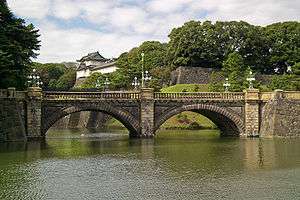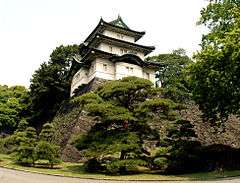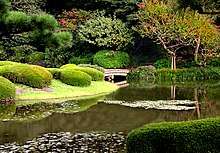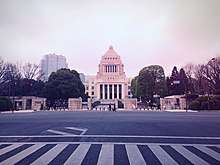Tokyo/Chiyoda
Chiyoda (千代田) Ward is the center of Tokyo and in many ways the center of all Japan. A mere 12 km² houses the Imperial Palace, the Diet, the ministries of Kasumigaseki, the corporate headquarters of Marunouchi, the controversial Yasukuni Shrine... and still has room left over for the shopping districts of Akihabara, Jinbōchō and Kanda.

Get in
Tokyo Station (東京駅 Tōkyō-eki), the hub for all Shinkansen trains, lies to the east side of Chiyoda. Note that the Shinkansen exits are on the Yaesu side in Chuo Ward; to get to the Marunouchi side in Chiyoda Ward, you want to cross over to the west exit. The west side of the station is something of a sight in itself as it reflects the station's original World War I-era architecture.
The JR Yamanote line (light green) passes through Tokyo Station in a loop around the center of the city, and the JR Chuo line (orange) and Sobu line (yellow) bisect the loop horizontally. Yurakucho, Akihabara, Kanda (on the Yamanote) and Ochanomizu, Yotsuya (on the Chuo) are among the train stations located within the ward. Narita Express trains from Narita Airport stop at Tokyo (¥2940, 53 min) on the Sobu platforms. The JR Keiyo Line services Tokyo station, and it transports passengers to destinations such as Kasai Rinkai Park, Tokyo Disney Resort, the Makuhari Messe, and destinations on the Boso peninsula via through services. Trains also frequently run through onto the Musashino Line to Saitama and western Tokyo, although some of these areas are reached faster via other lines. However, the platforms are located south of the main station complex. It was built for a new Shinkansen line, which is why it was built at an equal distance between Tokyo and Yurakucho stations. It can be a long walk to reach the rest of the train lines (even farther than transferring to the Tozai Line at Otemachi!), therefore in some cases it may be easier to walk to Yurakucho station.
Otemachi Station (大手町駅 Ōtemachi-eki), shared by five subway lines, is by far the largest subway station in Tokyo and sprawls under multiple city blocks underneath the Marunouchi district between Tokyo Station and the Imperial Palace. Transferring from, say, the Hanzomon Line to the Toei Mita Line here involves navigating a gauntlet of escalators and walking well over a kilometer. Tokyo and Otemachi station are connected to each other via underground passageways. Nijubashimae Station on the Chiyoda Line is also connected to Tokyo station, and is much closer to it than the line's own Otemachi station, although passengers riding the Romancecar service will still need to use Otemachi.
Many subway lines crisscross the district. These include the Marunouchi Line (red) (to Shinjuku), the Hanzomon Line (purple) (to Shibuya), the Hibiya Line (gray) (to Roppongi), the Tozai Line (blue) (to Nakano), and the Chiyoda Line (green) (to Harajuku). The nearby Toei Asakusa Line (pink) stops slightly to the east at Kyobashi and Nihonbashi, on which Keikyu Line trains run through to Haneda Airport (¥650, about 35 minutes).
By bus
Airport Limousine buses run from Narita to Tokyo Station every 10 to 20 minutes via the Tokyo City Air Terminal (1½-2 hours depending on traffic, ¥3000), and less frequently to area hotels. From Haneda, buses run every 30 to 40 minutes (about 45 minutes in duration, depending on traffic, ¥900).
See
Imperial Palace area

- 🌍 Imperial Palace (皇居 Kōkyo), ☎ +81 3-3213-1111. Surrounded by a series of moats and high walls, the site of the former Edo Castle has been the official residence of the Japanese imperial family since 1868. Reputedly the most expensive square kilometre in the world, which during the height of Japan's bubble was estimated to be worth slightly more than California. Unfortunately, the inner palace gardens and buildings are closed to the general public except on January 2 and December 23, when the imperial family makes a public appearance. However, foreigners can also apply online to join a free guided tour (weekdays at 10AM and 2PM). If you're feeling lucky, you can also try just showing up at the Imperial Household Agency office located in the northwest corner of the Imperial Palace Park, which is open 9 AM-noon, 1PM-2PM; if there's space, you can join a tour on the same day. Tours are conducted only in Japanese, but electronic audio guides (in English) will be lent to foreign visitors free of charge. At the end of the tour, visitors wishing to enter the East Gardens (see next entry) will be given entrance cards and allowed through to the gardens via a private gate, allowing them to bypass the lines at the main Ōte-mon entrance; pay attention to the announcement in Japanese and queue up as directed.

- 🌍 Imperial Palace East Garden. Open daily except Mondays and Fridays. Kept in impeccable shape, the gardens of the Imperial Palace are particularly beautiful during the March and April plum and cherry blossom seasons. Entrance is free through a number of gates; you will be given a plastic entrance card at the gate, which you are obliged to return upon leaving; most visitors use the Ōte-mon (大手門) gate near the Ōtemachi subway station (exit C10). Also an easy walking distance from Tokyo station.
- 🌍 Kitanomaru Park (北の丸公園, kita-no-maru kōen). Connected to the East Gardens on the North side is this park. Offering much of the same, it is a convenient way to get to Yasukuni Shrine. The park also houses the Nippon Budōkan (日本武道館), which regularly stages martial arts competitions and live concerts, as well as the Kagaku Gijyutsukan (科学技術館, Science museum).
_26_Mar%2C_2013_-_panoramio.jpg)
- 🌍 Chidoriga-fuchi Moat (千鳥ヶ淵), on the Northwest side of the Imperial gardens grounds. One of, if not the most prominent cherry blossom site in Tokyo, and attracts throngs of people in its March-to-April peak season. It is located just across the street from Yasukuni-shrine. Rowboats are also available for one to row along a limited portion of the moat at ¥500 for 30 minutes, ¥1000 for an hour and at a slightly more expensive rate during cherry blossom periods.
- 🌍 Yasukuni Shrine (靖國神社 Yasukuni-jinja), 3-1-1 Kudan-kita, ☎ +81 3-3261-8326. A controversial shrine to Japan's war dead, housing the souls of some 2.5 million people killed in Japan's wars — including convicted war criminals executed by the Allies. A favorite haunt of right-wing groups in black loudspeaker-equipped trucks. Open daily and free entrance adjacent to Metro Hanzomon line Kudanshita station, or cross the bridge north from Kitanomaru Park. Festivals take place most notably in mid-July and mid-October, which can attract as many people and vendors as it does on New Year's Day when the Japanese come to pray for a prosperous year. It can also get quite crowded during cherry blossom season.
- 🌍 Yūshūkan War Memorial Museum (遊就館) (adjacent to the shrine). Daily 9AM-5PM. An odd collection of military paraphernalia (including human torpedoes and letters from kamikaze pilots) and one-sided descriptions of Imperial Japan and World War II, but it can be pretty confronting at times. The museum includes a small military history book and model shop. Entry a rather steep ¥800.
Shrines and churches
- 🌍 Holy Resurrection Cathedral (ニコライ堂 Nikorai-do), ☎ +81 3-3291-1885. A beautifully-restored 1800s-vintage Russian Orthodox cathedral located near Ochanomizu Station on the Chuo Line. Use the Hijiribashi exit. The Hijiribashi bridge by the exit is one of the better looking bridges in Tokyo and looks moderately attractive when lit-up at night.
- 🌍 Kanda Shrine (神田明神 Kanda-myojin), A block north across the river from Ochanomizu station. This shrine has a history dating back to the 8th century and had been highly regarded under the Edo shogunate. The current red-pillared structure has been rebuilt after being completely destroyed in the 1923 Great Kanto Earthquake. The Kanda Matsuri festival, which takes place in mid-May every other year is one of the largest in Tokyo and is a sight to behold. Arrive before noon or the shrine gets packed with spectators.
- 🌍 Hie Shrine (日枝神社, Hie Jinja) (Located on the opposite side of the Imperial garden; a five minute walk from Kokkai-gijidō-mae station on the Metro Chiyoda line), ☎ +81 3-3581-2471. Another prominent shrine in Tokyo. Located atop a little hill at the edge of the area. Reached by a steep flight of stairs under a veritable tunnel of orange torii, the shrine grounds are an oasis of tranquility in the middle of Tokyo and, in good weather, a popular place for a lunchtime picnic. The Sanno Matsuri (山王祭) festival it hosts in June is counted among the 3 Great festival of Tokyo, featuring the usual panoply of music, dancing, yatai stalls and sake.
Other
Japan's administrative center, located around Kasumigaseki and Nagatachō in the southwestern corner of Chiyoda, is full of very un-picturesque buildings. One exception is the Ministry of Justice (exit 5 from Sakuradamon, Yurakuchō Line), a beautiful 1800s-vintage building that would make any European capital proud. The National Diet Building (Kokkai-gijidō-mae, Marunouchi Line) may also be worth a photo, although its architecture is rather uninspiring compared to other national assemblies' -- even the Tokyo Metropolitan Government has cooler-looking accommodations in Shinjuku.
- 🌍 Tokyo National Museum of Modern Art (東京国立近代美術館, Tōkyō Kokuritsu Kindai Bijutsukan), 3-1 Kitanomaru-kōen (Closest to Takebashi station on the Tōzai subway line), ☎ +81 3-5777-8600. Tu-Th, Sa-Su 10:30AM-5PM, F 10:30AM-8PM, closed M. With a modest permanent collection on display and regularly changing exhibitions, MOMAT is a nice place to kill a couple of hours after you've seen the Imperial Palace across the road. Entry to the nearby Crafts Gallery is included in the price. ¥420 for adults, ¥130 for students and children under 15 free. Admission is also free on May 18, November 3 and the first Sunday of every month. Special exhibits extra.
- 🌍 Idemitsu Museum of Arts (出光美術館, Idemitsu Bijutsukan), On the 9th floor of the Imperial Theatre building (on the East side of the Imperial gardens), ☎ +81 35777 8600. Daily 10AM-5PM (until 7PM on Fridays). Has a noteworthy collection centering on Japanese traditional arts. ¥1000 for adults.
- 🌍 Tokyo International Forum (東京国際フォーラム, Tōkyō Kokusai Fōramu), located in front of Yurakuchō station, ☎ +81 3-5221-9000. A massive, modern exhibition centre used for concerts, conventions and the like. On weekdays there are usually several food wagons selling boxed lunches, but aside from this there may not be much of interest to the casual tourist -- except, of course, the impressive design. The atrium may be the most well-known symbol of the building, and one is able to stroll up the long, spiral walkway that runs along its glass-and-steel walls. The Tokyo Tourist Info Center, which used to be here, has been relocated to Shinjuku.
- 🌍 National Theatre of Japan (国立劇場, Kokuritsu Gekijō) (walking distance from either Hanzomon or Nagatacho stations of the Metro Hanzomon lines et. al.), ☎ +81 3-3265-7411. For those interested in theatre arts, the Kokuritsu Gekijyo holds performances in traditional arts ranging from Kabuki, Noh drama, Bunraku puppet theatre, etc. You may want to check the schedule and make a reservation beforehand.

- 🌍 National Diet Building (国会議事堂). Housing Japan's bicameral legislature, it was built in the 1920s. The most recognizable symbol of the Japanese government, it was built from Japanese building materials, features a pyramidal roof and is surrounded with green areas. The nearby free Kensei Kinenkan (between the Diet and the water) has a nice view on it, and tons of political artefacts to satisfy those interested in Japanese politics.
Do
Visit one of the three major shrines (Kanda Myojin, Hie Jinja or Yasukuni Shrine) during the New Year holiday if you happen to be visiting, or immerse yourself in one of the major festivals which takes place during the year. There are no restrictions on entry regardless of religious belief or background.
As stated in the See section, cherry blossoms can be viewed in various places around the Imperial Palace gardens. Also, many people take advantage of the fact that no public roads enter the palace grounds (and thus, no red lights for pedestrians) for a little jogging around the garden's outer ring (which may take roughly an hour to walk around). However, since most of central Chiyoda Ward is office buildings, it is virtually lifeless after sundown as most of the population leaves for the suburbs.
Buy
Central Chiyoda doesn't offer much in the way of shopping, but the eastern side has three areas of interest:
- Akihabara for electronics and anime-related goods of all kinds, covered in a separate article.
- Jimbōchō (神保町), Metro Hanzomon/Tōei Shinjuku/Tōei Mita Jimbōchō station. A district specializing in new and used books — mostly in Japanese, but some in English and other languages. Scores of used book or antique book shops line the main streets of Hakusan Dōri (白山道り), Yasukuni Dōri (靖国道り), and Kanda Suzuran Dōri (神田すずらん通り), as well the numerous back alleys. Some stores specialize in subjects such as religion, architecture, or screenplays, while others handle a general range of subjects. Some shops specialize in various erotic material, including used pornography.
- Kanda (神田) and Ochanomizu (お茶の水) Stations. For musical instruments and sports equipment. These districts tend to have their largest stores along major streets. The area close to Ochanomizu stations is full of music shops, at least 30 of them with shiny instruments and music blaring throughout the day.
Some other shopping areas include:
- A recent revamping of the Marunouchi business district has resulted in some high-end boutiques such as Tiffany's, Gaultier, Sergio Rossi etc. lining the street from the Marunouchi building to Yurakuchō, but there is a feeling that it's not quite "there" yet, compared to the repertoires of the Ginza or Omotesando shopping districts.
- 🌍 Bic Camera. A huge, six-floor electronics store in front of JR Yurakucho Station, selling everything from household appliances to contact lenses. There is even a small movie theater on the 7th and 8th floors showing lesser-known Japanese and foreign films. Perhaps a good place for a one-stop shop if you are not able to spend time exploring the streets of Akihabara.
- 🌍 Maruzen bookshop (In the Oazo building in front of Tokyo Station). It may be your best bet to look for English books in Tokyo, including a "Books on Japan" section. If you don't find what you are looking for here, you probably won't have much luck looking elsewhere.
- 🌍 KITTE (JP Tower), 2-7-2 Marunouchi. 11:00-23:00. The former Japan Post headquarters have been renovated into a trendy building with many shops and restaurants. The top roof is an open garden giving an amazing view on Tokyo Station, perfect for watching bullet trains come and go.
Eat and drink
- Among the expensive clubs and restaurants spilling over from the Ginza, an offbeat dining option is the yakitori stalls under the train tracks near JR Yurakucho station. A throwback to old Tokyo, this is where businessmen unwind with yakitori (grilled chicken) on skewers and a couple of nama biiru (draft beers) after a hard day. At least ¥2000 for a few beers and a half dozen skewers.
- As the Jimbocho and Ochanomizu areas house dozens of major colleges and universities, the area is filled with cheap restaurants, fast food joints and cafes of all kinds. There is also a high density of curry restaurants.
- The Marunouchi Building and Shin-Marunouchi Building in front of Tokyo station are your best bet for a decent meal in the Marunouchi area, especially on the weekend when most other buildings are closed. Various restaurants from Italian to Hawaiian to Sushi are situated inside, but the bill may be a bit pricy for a casual lunch.
- 🌍 Peter, 24th Floor, Hotel Peninsula (Private lift from hotel lobby), ☎ +81 3-6270 2763. Restaurant with amazing views of Imperial Palace and excellent service. Lunch seems the best value. Kobe beef from 23,500¥. Dress code: casual. Lunch from ¥4900.
- 🌍 Tokyo Sundubu. Cheap and classy Korean food just in front of the Imperial Palace East Gardens. They serve hot tofu-based soups with rice. You can choose from not spicy at all to very spicy. 1000¥ lunch/dinner.
- 🌍 Yamaya (やまや). For lunch you should get a bowl of rice with mentaiko (semi-spicy red fish eggs). Their specialty for dinner is motsunabe (tripe soup). ¥1000 lunch, ¥3000 dinner.
Sleep
Budget
- Green Ochanomizu Hotel, Kanda-Awajicho 2-6 (5 minutes from JR Ochanomizu Station and near the center of the Yamanote Line), ☎ +81 3 3255-4161. Green Hotel Ochanomizu is an extremely accommodating hotel, perfect for the traveler who prefers a quiet sanctuary in the hustle and bustle. Ochanomizu station itself is but two stops from both Tokyo and Shinjuku, via the Rapid Chuo Line service, both of which are on Yamanote. Broadband access is free in most rooms. Singles at around ¥8400 and doubles at ¥9500.
- Tokyo Central Youth Hostel, 1-1 Kagurakashi, Shinjuku-ku (in the far east end of Shinjuku, far from its station, and just in the north of Chiyoda, 800m away from the Imperial Palace area), ☎ +81 3-3235-1107, fax: +81 3-3267-4000, e-mail: tcyh@jyh.gr.jp. Located on the 18th and 19th floors of a high-rise, with great views over the city (including a hot tub and baths overlooking the lights and skyscrapers of Shinjuku) and comfortable rooms. Formerly known as Tokyo International Hostel. ¥4050.
Mid-range
- 🌍 Tokyo Station Hotel, Marunouchi 1-chome 9-1, ☎ +81 3-3231-2511. If you ever wanted to sleep in a train station, then this might be the place to do it. This convenient hotel makes up a part of the 1914 red-brick building that is the terminal station of all but one of the country's Shinkansen lines. It is within easy walking distance of the Imperial Palace, and you can simply walk out of the lobby and make a U-turn to catch a train like the Yamanote line. Citibank ATM is a few minutes' walk away in Ōtemachi. Before being closed for renovations, the rates were ¥11600/15000/17300 singles, ¥19600/26600/30000 twins, ¥26600 double, ¥34700 triple (including taxes). 10% discount with an active Japan Rail Pass or JR East Rail Pass..
Splurge
- Imperial Hotel Tokyo (帝国ホテル Teikoku Hoteru), Uchisaiwaicho 1-1-1, ☎ +81 3 3504-1251. Never mind upstarts like the Park Hyatt, this is the grand old dame of Tokyo's hotels with over 115 years of history behind it and legendary service fit for an Emperor. Standard rooms are musty, but the refurbished Imperial Floor rooms are nice. The hotel overlooks Hibiya Park and is only a short walk from the Imperial Palace and the Ginza. ¥43,000 and higher.
- 🌍 The New Otani, Kioicho 4-1, ☎ +81 3 3265-1111. The flagship of the international New Otani chain, and one of the largest hotels in Tokyo, with a variety of shops and restaurants under its roof. Convenient for business travellers, as it is located within an easy walk of Akasaka, Nagatacho, and other international business districts; less convenient for tourists, although somewhat close to Roppongi, Shinjuku, and other play areas. ¥36,000 and up.
Connect
- The Tokyo Tourist Information Center has moved from Yurakucho's International Forum to the Tokyo Metropolitan Government Building in Shinjuku.
Stay safe
On occasion, menacing black vans with fluttering "Rising Sun" flags and Imperial chrysanthemum logos may screech militaristic propaganda around the Yasukuni Shrine and near the Nagatacho/Kasumigaseki areas. With xenophobic right-wing attitudes financed by the yakuza (Japan's mafia) and tacit police cooperation, foreigners may get baleful looks from the sunglassed toughs running the show, but they are not a real danger unless actively provoked.
Smoking on the major streets and sidewalks is prohibited by law in Chiyoda Ward. Although generally not strictly enforced, if you get unlucky, fines go up to ¥20,000. There are smokers' gardens at the end of some main streets and behind some of the skyscrapers where you can light up legally.
Go next
The glitzy stores of the Ginza and the business district of Akasaka (not a bad choice for lunch) are within easy walking distance from southern Chiyoda.
| Routes through Chiyoda |
| Yokohama ← Tokyo Shinagawa ← | W |
→ END |
| Nagano ← Takasaki ← Kumagaya ← | N |
→ END |
| Niigata ← Takasaki ← Kumagaya ← | N |
→ END |
| Sendai ← Nasu Shiobara ← Utsunomiya ← | N |
→ END |
| Shinjuku ← into |
W |
→ Kinshicho → Shin Koiwa → Chiba |
| Yokohama ← Tokyo Shimbashi ← | W |
→ END |
| Kofu ← Hachioji ← Nakano ← | W |
→ END |
| Ōmiya ← Akabane ← Tokyo/Ueno ← | N |
→ END |
| Zushi ← Kamakura ← Yokohama ← | W |
→ into |
| Ikebukuro ← Ueno ← Akihabara ← | N |
→ Hamamatsucho → Shinbashi → Shinagawa |